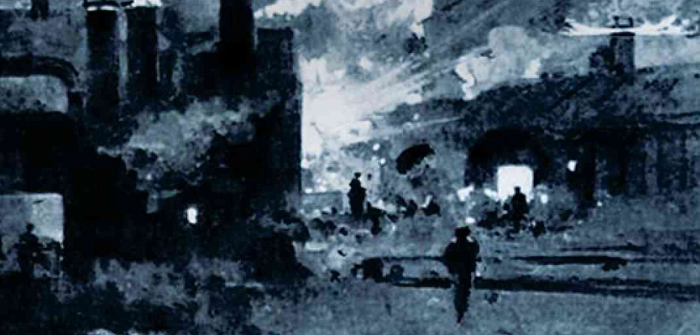Intimidation is a history of what became known as The Sheffield Outrages of the mid-19th century in Sheffield, England. Like many urban centres, Sheffield had experienced exponential growth in population as the Industrial Revolution took hold. The city was building a worldwide reputation for iron, steel, cutting tools and most famously, cutlery, with these trades moving from small cottage industries to larger factory settings.
The combination of increasingly mechanised work and more workers in the same place led to the formation of trade unions which were on very shaky legal ground because ‘combinations’ of workers were illegal – but not ‘combinations’ of owners and proprietors. Although, broadly speaking, economic times were good in the mid-19th century, there were, of course, times of difficulty and this was when the workers, more than ever, needed to band together. Factory owners and masters would unilaterally cut wages in tough times, making the hard times workers experienced even harder.
Drewry writes about the appalling conditions in which the working class lived and worked. When he quotes Charles Dickens’ description of the housing and living conditions of a brickmaker, as described by a middle class do-gooder in Bleak House, he is making the point that the workers knew they lived in filthy, unhealthy conditions and drank too much – how else could they tolerate such miserable lives. They didn’t go to church and didn’t need the middle class to distribute improving tracts for them to read – most were illiterate anyway. What they needed was the middle class to stop exploiting the workers and give them a hand up.
It is surprising to read that the most of the intimidation and outrages were conducted by trade union members against other trade union members rather than owners. The most frequent issue was failure to pay union dues for which the trade unions had no legal recourse. A few owners or masters were also targeted for bringing in non-union workers; especially strike breakers.
A Royal Commission was set up to enquire into events specifically in the city and its environs and very unusually, those giving evidence were granted immunity from prosecution if they made a full and frank confession. The outrages reported ranged from attacking animals belong to the person being targeted, to beatings, improvised bombs, and finally being shot at and killed.
Unfortunately, Drewry’s writing about the various incidents reads like a very long and dull laundry list, with details drawn from the proceedings of the Royal Commission. For example, we have Henry Bridges’ Broken Bricks, and then later we have two chapters on the doings of the Scissor Grinders’ Union plus another chapter on the Scissor Forgers’ Society.
I agree with Drewry that this important period of Sheffield’s industrial history deserves to be better known and considered within the context of its time – a much more brutal and violent society than today’s. As Sheffield, England is my home town, I was looking forward to learning about its history but I was disappointed by Drewry’s book. I found his narrative plodding and it would have benefited greatly from some thoughtful editing.
Reviewed by Jan Kershaw
Rating out of 10: 6
Distributed by: Austin Macauley and available through Amazon Australia
Released: October 2018
RRP: $28.40 paperback





















